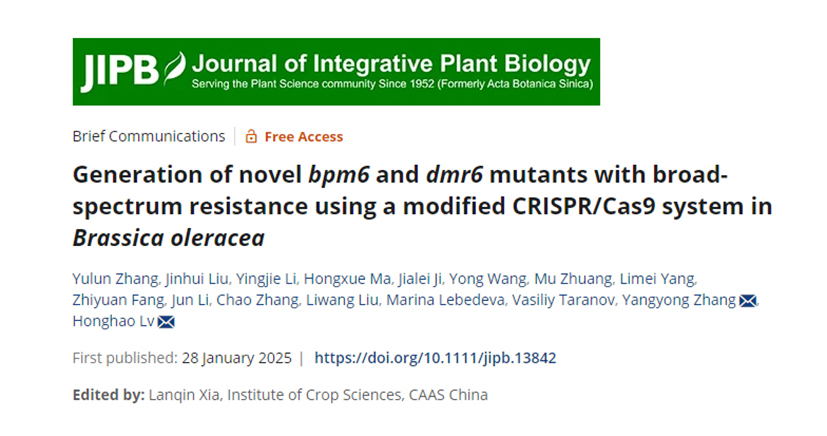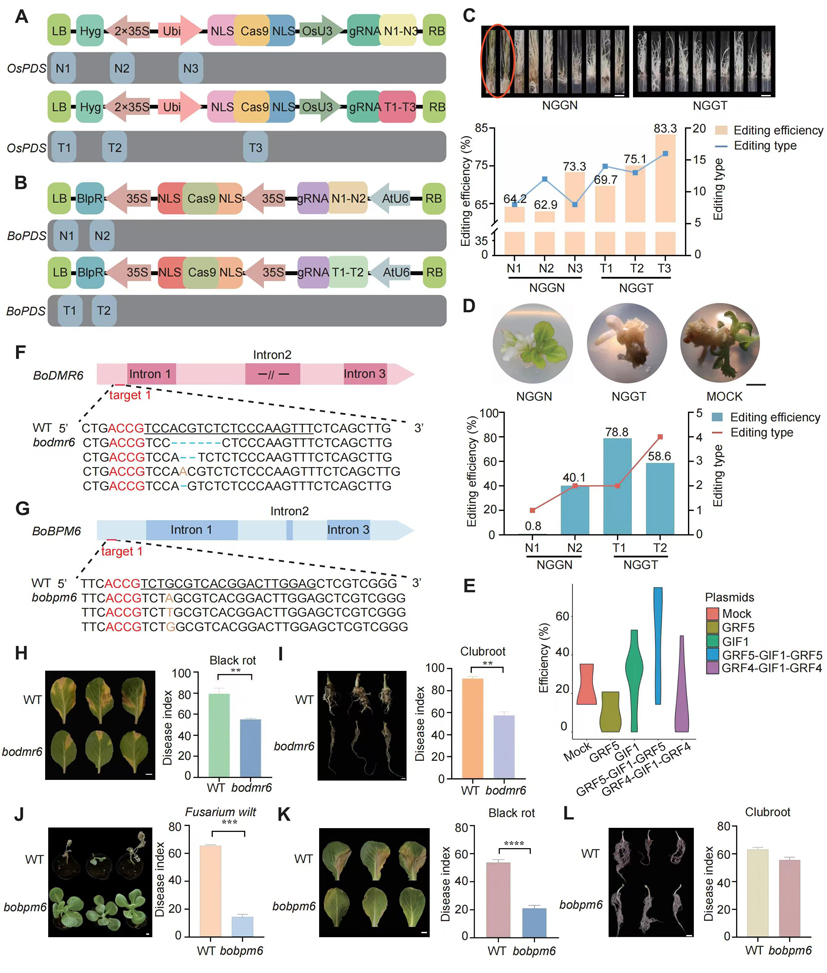Recently, the Cabbage Genetic Breeding Innovation Team at the Institute of Vegetables and Flowers, Chinese Academy of Agricultural Sciences, enhanced the efficiency of B. oleracea genetic transformation and CRISPR/Cas9 gene editing by optimizing the PAM sequence and expressing the GRF-GIF fusion protein. By utilizing the optimized CRISPR/Cas9 system, the team successfully knocked out the BoBPM6 and BoDMR6 genes, leading to the creation of new germplasm with broad-spectrum disease resistance. The related findings were published in the Journal of Integrative Plant Biology, under the title "Generation of novel bpm6 and dmr6 mutants with broad-spectrum resistance using a modified CRISPR/Cas9 system in Brassica oleracea."

Brassica oleracea, an important biennial herbaceous species in the Cruciferae family, is widely cultivated around the world. With an estimated 3.77 million hectares planted worldwide, these cole crops, for instance, cabbage, broccoli, and cauliflower, constitute significant agricultural resources. Field diseases often result in reduced crop yields, making the development of broad-spectrum disease resistant varieties an ideal strategy for control. Using gene editing technologies such as CRISPR/Cas9, which enable the knockout of susceptibility genes, have emerged as a rapid and straightforward method for achieving broad-spectrum resistance. At present, there are few broad-spectrum disease resistant varieties of B. oleracea, and the gene editing efficiency in B. oleracea is relatively low compared to model crops like rice. Therefore, improving the CRISPR/Cas9 gene editing system and exploring the creation of new germplasm with broad-spectrum disease resistance is crucial.
This study applied a strategy that selects 'T' as the base following the PAM sequence 5’-NGG-3’, constructing two distinct vectors for monocot rice and dicot cabbage. This strategy was verified to increase the editing efficiency of CRISPR/Cas9 gene editing technology to 76.0% and 68.7%, respectively. During the genetic transformation process, the expression of GRF5-GIF1-GRF5, GRF4-GIF1-GRF4, GRF5, and GIF1 proteins was assessed, with results indicating that the expression of the GRF5-GIF1-GRF5 fusion protein significantly enhanced the regeneration rate by 55.2%. Using the optimized gene editing and genetic transformation system, the BoBPM6 and BoDMR6 genes were knocked out, resulting in bobpm6 and bodmr6 mutant materials with average transformation and editing rates of 5.5% and 62.0%, and 8.2% and 62.5%, respectively. Artificial inoculation tests for three major cabbage diseases—Fusarium wilt, black rot, and clubroot—revealed that bobpm6 significantly enhanced resistance to Fusarium wilt and black rot, while bodmr6 significantly enhanced resistance to black rot and clubroot. In summary, the application of the optimized CRISPR/Cas9 technology to knock out the BoBPM6 and BoDMR6 genes resulted in the creation of new germplasms with broad-spectrum disease resistance. Our findings provide robust support for gene editing and disease resistance breeding techniques in B. oleracea.

Figure 1: Strategies employed for the updating and application of the CRISPR/Cas9 editing system.
The co-first authors of the paper are Yulun Zhang, a joint graduate student from the Institute of Vegetables and Flowers, Chinese Academy of Agricultural Sciences/Beijing University of Agriculture, and Jinhui Liu, a recent master's graduate. The co-corresponding authors are researchers Honghao Lv and Yangyong Zhang. The research was supported by the National Key Research and Development Program of China, the Key Technology Research and Development Program of Jiangsu Province, the Science and Technology Program of Hebei Province, and others. Additionally, this study was partially funded by the Russian Ministry of Science and Higher Education.
Original link: https://doi.org/10.1111/jipb.13842